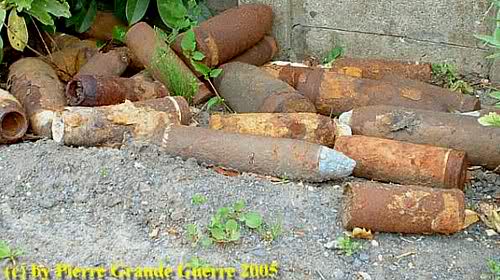Schroot
DUTCH Page - Column d.d. 29 september 2007

Vanaf vrijdag heb ik niets meer van me laten horen. Het was druk, het was gezellig, het was laat, het was vermoeiend: ik ben suf gepraat. Zelfs voor dit columnpje weet ik nauwelijx de juiste woorden op het beeldscherm te kloppen. Een saai weekend was het zeker niet.
Vrijdagmiddag trof ik bij toeval in het Koffiehuis op het Eiland de Archeoloog. Hij is altijd enthousiast over zijn beroep en hij beschikt over de gave om ook aan mij, de leek, de ingewikkeldste zaken uit te leggen. Hij is geen nerd, maar iemand die met zijn lieslaarzen in de klei staat te passen en te meten op zoek naar overblijfselen van het Pleistoceen.
Terwijl ik luisterde aan de stamtafel naar zijn uiteenzetting over “kloostermoppen” in vroegmiddeleeuwse kastelen -, een op het eerste gezicht saai onderwerp maar zeker niet in dit geval,- bedacht ik me dat ik nu mijn kans moest grijpen om de Archeoloog een prangende vraag te stellen, die al langer door mijn hoofd jaagt.
De “haunting question” gaat over een natuurkundig proces, waardoor explosieven, zoals granaten, metaalresten en lijken na negentig jaar nog omhoog geploegd worden door de boeren langs het 650 kilometerslange Westelijk Front. Een breed lint van Diksmuide in België tot aan de Vogezen in Frankrijk; overal ploegen de boeren elk voorjaar de “bommekes” van 90 jaar oud uit de grond.
Kortom: Waarom komt er elk vroeg voorjaar weer voor duizenden tonnen schroot en springstoffen naar boven in de velden langs het front?
Tijdens een korte pauze in het betoog van de Archeoloog, merkte ik dat hij de vroege middeleeuwen niet diep genoeg in de grond vond zitten voor zijn ware interesse. Ik maakte gebruik van het moment en ik stelde mijn kwellende vraag.
Allereerst begreep de Archeoloog mijn vraag niet. Stel je voor: ik stelde geen vraag over een grondlaag, die tientallen meters diep ligt. Nee, ik vroeg iets over een diepte van slechts 75 centimeter tot 1 meter 50, net onder het ploegoppervlak.
Met een tikkeltje dédain wilde hij eerst mijn vraag afwimpelen: niet diep genoeg natuurlijk. Daar was ik al bang voor. Op mijn toelichting draaide hij echter bij. Hij zag het interessante kennelijk in van mijn vraag.
In vijf zinnen legde hij me uit, hoe het zat met de bevriezing van de toplaag van het aardoppervlak, het doorsijpelen naar beneden, vervolgens de bevriezing van het grondwater waardoor er een vacuüm-achtige zuigwerking en een stuwing omhoog van grondlagen plaatsvindt. Alles wat zich daar in bevindt, wordt mee omhoog gevoerd tot juist onder de ploeglaag of in de ploeglaag; schroot, granaten, lijken, en allerlei klein spul, dat soldaten bij zich plegen te hebben.
Na al die keren door de zuigende modder op die slagvelden gestrompeld te hebben, begreep ik eindelijk hoe dit proces in zijn werk ging. Boeken hadden me het nooit kunnen uitleggen. De Archeoloog wist mij dit proces, op zijn gemak achter zijn Koffie Verkeerd, in vijf simpele zinnen voor mij begrijpelijk uit te leggen. Verlost was ik van mijn kwellende vraag! Ik liet hem merken, dat hij me blij had gemaakt met zijn antwoord. Jammer, dat hij weer weg moest.
Met zo’n vent zou ik wel eens over Pilkem Ridgewillen strompelen in de Westvlaamse klei. Want ik heb nog genoeg vragen liggen, die me niet zo najagen, maar daarom niet minder interessant zijn.
Dit was pas de vrijdagmiddag. Misschien begrijpelijk voor u, dat ik aan de rest van het weekend niet meer toe kom in één columnpje?
Pierre










